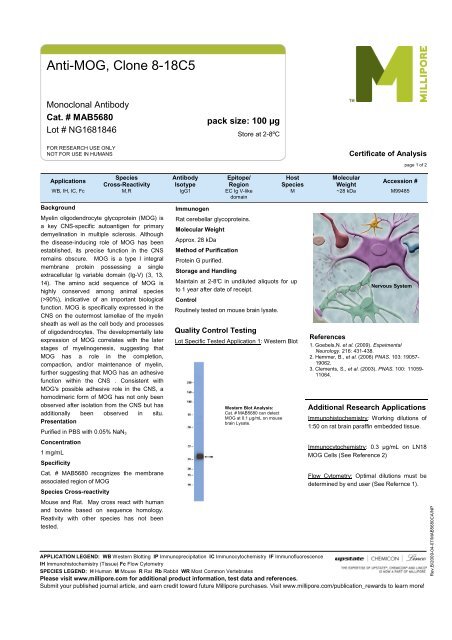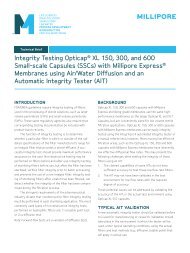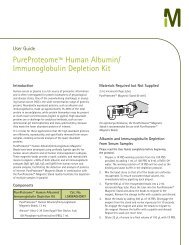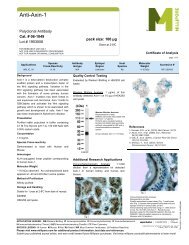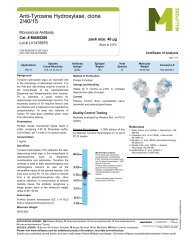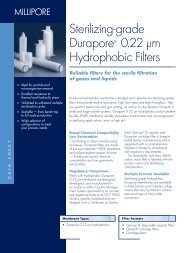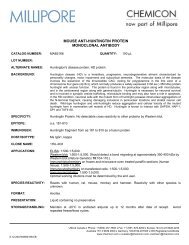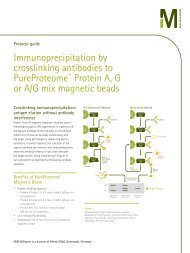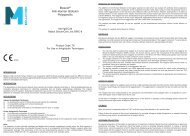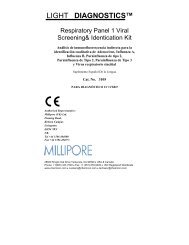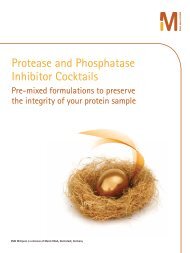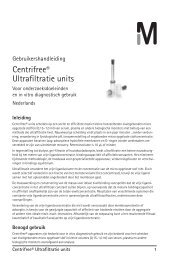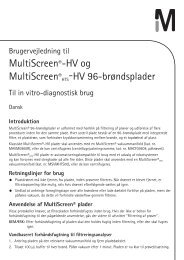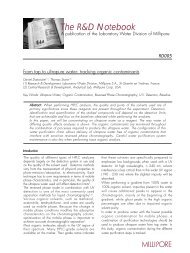Anti-MOG, Clone 8-18C5 - Millipore
Anti-MOG, Clone 8-18C5 - Millipore
Anti-MOG, Clone 8-18C5 - Millipore
You also want an ePaper? Increase the reach of your titles
YUMPU automatically turns print PDFs into web optimized ePapers that Google loves.
<strong>Anti</strong>-<strong>MOG</strong>, <strong>Clone</strong> 8-<strong>18C5</strong><br />
Monoclonal <strong>Anti</strong>body<br />
Cat. # MAB5680<br />
Lot # NG1681846<br />
FOR RESEARCH USE ONLY<br />
NOT FOR USE IN HUMANS<br />
Background<br />
Myelin oligodendrocyte glycoprotein (<strong>MOG</strong>) is<br />
a key CNS-specific autoantigen for primary<br />
demyelination in multiple sclerosis. Although<br />
the disease-inducing role of <strong>MOG</strong> has been<br />
established, its precise function in the CNS<br />
remains obscure. <strong>MOG</strong> is a type I integral<br />
membrane protein possessing a single<br />
extracellular Ig variable domain (Ig-V) (3, 13,<br />
14). The amino acid sequence of <strong>MOG</strong> is<br />
highly conserved among animal species<br />
(>90%), indicative of an important biological<br />
function. <strong>MOG</strong> is specifically expressed in the<br />
CNS on the outermost lamellae of the myelin<br />
sheath as well as the cell body and processes<br />
of oligodendrocytes. The developmentally late<br />
expression of <strong>MOG</strong> correlates with the later<br />
stages of myelinogenesis, suggesting that<br />
<strong>MOG</strong> has a role in the completion,<br />
compaction, and/or maintenance of myelin,<br />
further suggesting that <strong>MOG</strong> has an adhesive<br />
function within the CNS . Consistent with<br />
<strong>MOG</strong>'s possible adhesive role in the CNS, a<br />
homodimeric form of <strong>MOG</strong> has not only been<br />
observed after isolation from the CNS but has<br />
additionally been observed in situ.<br />
Presentation<br />
Purified in PBS with 0.05% NaN3<br />
Concentration<br />
1 mg/mL<br />
Specificity<br />
Cat. # MAB5680 recognizes the membrane<br />
associated region of <strong>MOG</strong><br />
Species Cross-reactivity<br />
Mouse and Rat. May cross react with human<br />
and bovine based on sequence homology.<br />
Reativity with other species has not been<br />
tested.<br />
Immunogen<br />
Rat cerebellar glycoproteins.<br />
Molecular Weight<br />
Approx. 28 kDa<br />
Method of Purification<br />
Protein G purified.<br />
Storage and Handling<br />
Maintain at 2-8°C in undiluted aliquots for up<br />
to 1 year after date of receipt.<br />
Control<br />
pack size: 100 µg<br />
Applications<br />
Species<br />
Cross-Reactivity<br />
<strong>Anti</strong>body<br />
Isotype<br />
Epitope/<br />
Region<br />
WB, IH, IC, Fc M,R IgG1 EC Ig V-like<br />
domain<br />
Routinely tested on mouse brain lysate.<br />
Quality Control Testing<br />
Store at 2-8ºC<br />
Lot Specific Tested Application 1: Western Blot<br />
Western Blot Analysis:<br />
Cat. # MAB5680 can detect<br />
<strong>MOG</strong> at 0.1 µg/mL on mouse<br />
brain Lysate.<br />
Certificate of Analysis<br />
page 1 of 2<br />
Host<br />
Species<br />
Molecular<br />
Weight<br />
Accession #<br />
M ~28 kDa M99485<br />
Nervous System<br />
References<br />
1. Goebels,N. et al. (2009). Expeimental<br />
Neurology. 216: 431-438.<br />
2. Hemmer, B., et al. (2006) PNAS. 103: 19057-<br />
19062.<br />
3. Clements, S., et al. (2003). PNAS. 100: 11059-<br />
11064.<br />
Additional Research Applications<br />
Immunohistochemistry: Working dilutions of<br />
1:50 on rat brain paraffin embedded tissue.<br />
Immunocytochemistry: 0.3 µg/mL on LN18<br />
<strong>MOG</strong> Cells (See Reference 2)<br />
Flow Cytometry: Optimal dilutions must be<br />
determined by end user (See Refernce 1).<br />
APPLICATION LEGEND: WB Western Blotting IP Immunoprecipitation IC Immunocytochemistry IF Immunofluorescence<br />
IH Immunohistochemistry (Tissue) Fc Flow Cytometry<br />
SPECIES LEGEND: H Human M Mouse R Rat Rb Rabbit WR Most Common Vertebrates<br />
Please visit www.millipore.com for additional product information, test data and references.<br />
Submit your published journal article, and earn credit toward future <strong>Millipore</strong> purchases. Visit www.millipore.com/publication_rewards to learn more!<br />
Rev.B/2009-04-07/MAB5680CA/NP
<strong>Anti</strong>-<strong>MOG</strong>, <strong>Clone</strong> 8-<strong>18C5</strong><br />
Cat # MAB5680<br />
Lot #NG1681846<br />
Additional Research Applications<br />
Immunohistochemistry (Paraffin):<br />
PROTOCOL<br />
Western Blot Protocol<br />
1. Mix the samples (organ membranes: 50 µg/lane; transfected cells: 500,000 cells/lane) with sample-buffer X 2, and heat 10 min at 70°C.<br />
2. 5-50 µL applied to Minigel lane (0.75-1.5 mm width) and run at standard conditions. (60 mA for 2 1.5 mm Minigel gels, 1.4 h). It is suggested<br />
that you run 5-15% acrylamide (37.5:1 acrylamide:bisacrysmide) minigel (1.5 mm width) at 30 mA/gel ~1-1.5 hours.<br />
3. Transfer in semi-dry system under standard conditions (3 h 100 mA for two minigel gels)<br />
4. Stain the transferred bands with <strong>Millipore</strong> BLOT-FastStain (Catalog Number 2076).<br />
5. Destain with deionized water.<br />
6. Block with 5% non-fat milk (Marvel or Carnation) in PBS, and 0.025 % sodium azide, overnight at 2-8°C. The non-fat milk should be dissolved<br />
freshly, centrifuged 10,000 rpm for 10 min, and filtered through glass filter (Gelman Acrodisc).<br />
7. Incubation with first antibody 2 h at room temperature or overnight at 4°C in blocking solution. Th e antibody preparation should be centrifuged<br />
before use (10,000 g for 5 min.). Optimal working dilutions and incubation time will need to be determined by the end user.<br />
8. Wash 4 x 10 min. with PBS-0.1% Tween 20. From this stage, azide should be omitted.<br />
9. Incubation with the secondary antibody (HRP-conjugated goat anti-rabbit antibody, for example <strong>Millipore</strong> Catalog Number AP132P, diluted<br />
appropriately) 1 h at room temperature.<br />
10. Wash 4 x 10 min. with PBS-0.1% tween 20.<br />
11. Perform ECL with commercial kits (Chemilucent, <strong>Millipore</strong> Catalog Number 2600).<br />
RELATED PRODUCTS (specific) RELATED PRODUCTS (non-specific)<br />
cat # description cat # description<br />
AB9730<br />
AB9734<br />
07-678<br />
AB15188<br />
AB9740<br />
<strong>Anti</strong>-14-3-3-β; 100 µL Polyclonal <strong>Anti</strong>body IPVH00010<br />
<strong>Anti</strong>-14-3-3-β N-Terminus; 100 µL Polyclonal <strong>Anti</strong>body IPFL00010<br />
<strong>Anti</strong>-Lingo-1; 100µg Polyclonal <strong>Anti</strong>body IPVH07850<br />
<strong>Anti</strong>-Neurofascin, NF186/NF155 Polyclonal <strong>Anti</strong>body ISEQ00010<br />
<strong>Anti</strong>-phospho-14-3-3 (Ser185) Polyclonal <strong>Anti</strong>body ISEQ07850<br />
IPFL07810<br />
WBKLS0100<br />
17-373<br />
2060<br />
2500<br />
B2080-<br />
175GM<br />
<strong>MOG</strong> (<strong>Clone</strong>: 8-<strong>18C5</strong>) representative staining pattern/morphology in<br />
rat brain. Tissue was pretreated with Citrate pH 6.0 for antigen<br />
retrieval. <strong>Anti</strong>body diluted to 1:50, IHC Select Detection System<br />
HRP/DAB. Immunoreactivity is highly specific to myelin fibers in<br />
cerebellum’s white matter layer.<br />
Immobilon-P 26.5 cm x 3.75 m Roll PVDF 0.45 µm<br />
Immobilon-FL 26.5 cm x 3.75 m Roll PVDF 0.45 µm<br />
Immobilon-P 7 x 8.4 cm PVDF 0.45 mm (sheet) 50/pk<br />
Immobilon-P SQ 26.5 cm x 3.75 m 1 roll PVDF 0.2 µm<br />
Immobilon-P 7 x 8.4 cm PVDF 0.2 mm (sheet) 50/pk<br />
Immobilon-FL 7 x 8.4 cm PVDF 0.45 mm (sheet) 10/pk<br />
Immobilon Western Chemilum HRP Substrate 100 mL<br />
Spray & Glow ECL WB Detection System 1 ea<br />
Re-Blot Western Blot Recycling Kit<br />
Re-Blot Plus Western Blot Recycling Kit<br />
Blot Quick Blocker Membrane Blocking Agent 175G<br />
antibodies Multiplex products biotools cell culture enzymes kits proteins/peptides siRNA/cDNA products<br />
Please visit www.millipore.com for additional product information, test data and references<br />
28820 Single Oak Drive • Temecula, CA 92590<br />
Technical Support: T: 1-800-MILLIPORE (1-800-645-5476) • F: 1-800-437-7502<br />
FOR RESEARCH USE ONLY. Not for use in diagnostic or therapeutic applications. Purchase of this Product does not include any right to resell or transfer, either as a stand-alone product or as<br />
a component of another product. Any use of this Product for purposes other than research is strictly prohibited without prior written authorization from an authorized officer of <strong>Millipore</strong> Corporation.<br />
Upstate®, Chemicon®, Linco® and all other trademarks are owned by <strong>Millipore</strong> Corporation. Copyright ©2008 <strong>Millipore</strong> Corporation. All rights reserved.<br />
page 2 of 2


